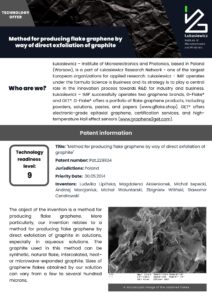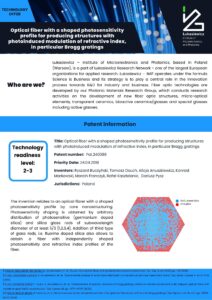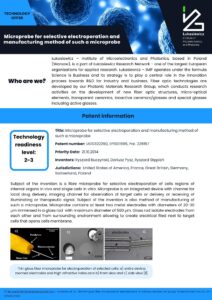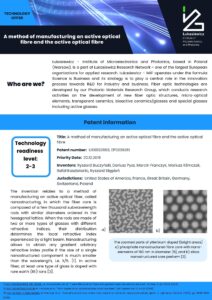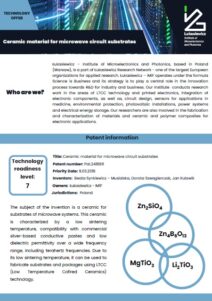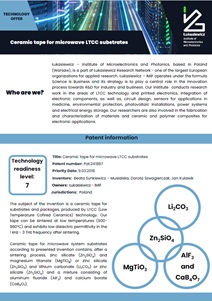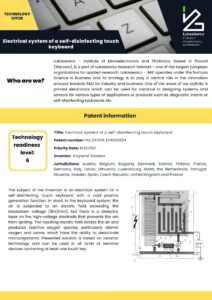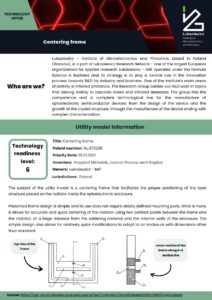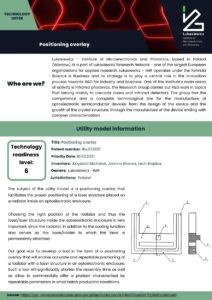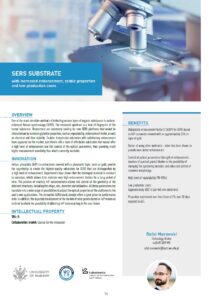Oferta technologiczna
Poniżej znajduje się lista praw własności przemysłowej obejmująca technologie wypracowane w Łukasiewicz – IMiF. Zainteresowanych zakupem lub licencjonowaniem praw do poniższych rozwiązań zapraszamy do kontaktu: komercjalizacja@imif.lukasiewicz.gov.pl
Production method of graphene foil with a pre-defined number of graphene layers
Patent information
Title: Production method of graphene foil with a pre-defined number of graphene layers
(PL: Sposób wytwarzania folii grafenowej ze wstępnie określoną liczbą warstw grafenowych)
Patent number: EP3098198
Application number: EP16168937
Application date: 10.05.2016
Inventors: Aleksandra Krajewska; Iwona Pasternak, Aleksandra Przewłoka, Włodzimierz Strupiński
Owner: Łukasiewicz – IMiF
Jurisdictions: France, Germany, Great Britain, Belgium, Netherlands, Spain, Italy and Poland
Espacenet: https://worldwide.espacenet.com/patent/search/family/056194215/publication/EP3098198A1?q=EP16168937
The technology in a nutshell
The present invention relates to a production method of graphene foil with a pre-defined number of graphene layers covering the following stages:
a) producing graphene on a metallic substrate;
b) depositing a polymer layer on the graphene surface;
c) separating the polymer/graphene stack from the metallic substrate characterized in that subsequently it comprises stages as follows;
d) transferring the obtained polymer/graphene stack directly onto the metallic substrate with at least one graphene layer deposited on top;
e) separating the polymer/graphene/ graphene stack from the metallic substrate.
Method for graphene layer transfer
Patent information
Title: Method for graphene layer transfer
(PL: Sposób przenoszenia warstwy grafenowej)
Patent number: Pat.224343
Application number: P.408660
Application date: 25.06.2024
Inventors: Iwona Pasternak, Aleksandra Krajewska, Włodzimierz Strupiński
Owner: Łukasiewicz – IMiF
Jurisdictions: Poland
Espacenet: https://worldwide.espacenet.com/patent/search/family/053039851/publication/PL224343B1?q=pn%3DPL224343B1
The technology in a nutshell
-
The process according to the invention allows the graphene layer to be transferred from the source substrate to the target substrate without the use of polymer support coatings.
-
This method guarantees a cleaner surface of graphene and no polymer residue on its surface. In addition, said procedure enables the transfer of the graphene to non-resistant acetone substrates, which is typically used to remove polymers. As a consequence, this significantly increases the possibilities of using graphene. In addition, there is no need for a special holder or any other complicated tools.
-
By applying the method, it is possible to transfer the unlimited shape of the graphene layers even to rough and developed surfaces such as nanowires or materials finished with nanoparticles.
Method of silvering surfaces, especially aluminium surfaces
Patent information
Title: Method of silvering surfaces, especially aluminium surfaces
(PL: Sposób srebrzenia powierzchni, zwłaszcza aluminium)
Patent number: EP2447313
Application number: EP11180709
Application date: 09.09.2011
Inventors: Marian Teodorczyk, Jeremiasz Olgierd, Mateusz Jarosz, Anna Młożniak, Małgorzata Jakubowska
Owner: Łukasiewicz – IMiF
Jurisdictions: Poland.
Espacenet: https://worldwide.espacenet.com/patent/search/family/044799628/publication/EP2447313B1?q=EP2447313
The technology in a nutshell
- The invention relates to a method of silvering surfaces sensitive to high temperatures, as for example aluminium surfaces, foils, paper or fabric.
- Presented method provides silvering aluminium surfaces, wherein the sintering stage is performed at temperatures significantly below the aluminium melting temperature, preferably within the range of about 200°C – 400°C, so that the aluminium surface being silvered remains undamaged after the sintering stage.
- Our method is capable of silvering the surfaces in a simple, rapid, an economical and an environmental friendly manner with high sensitivity and selectivity.
Method for obtaining graphene layers and paste comprising graphene nanoplatelets
Patent information
Title: Method for obtaining graphene layers and paste comprising graphene nanoplatelets
(PL: Sposób otrzymywania warstw grafenowych i pasta zawierająca nanopłatki grafenowe)
Patent number: Pat.222519, EP2570462
Application number: P.396373, EP12184435
Application date: 19.09.2011
Inventors: Małgorzata Jakubowska, Anna Młożniak, Marcin Słoma
Owner: Łukasiewicz – IMiF
Jurisdictions: Germany, France, Great Britain, Poland
Espacenet: https://worldwide.espacenet.com/patent/search/family/046924307/publication/EP2570462B1?q=EP2570462B1&queryLang=en%3Ade%3Afr
The technology in a nutshell
- Our invention focuses on producing graphene layers on a substrate is based on applying a paste comprising of graphene nanoplatelets mixed with an organic vehicle in the form of a polymethyl methacrylate solution in butyl carbitol acetate or in the form of a polycarbonate solution in butyl carbitol acetate on said substrate by the screen printing method.
- Our paste comprises additives which improve dispersion, selected from a group comprising agents which reduce surface tension, facilitate de-agglomeration, prevent re-agglomeration and sedimentation of the filler and additives improving the rheology of the paste.
Method for producing flake graphene by way of direct exfoliation of graphite
Patent information
Title: Method for producing flake graphene by way of direct exfoliation of graphite
(PL: Sposób wytwarzania grafenu płatkowego na drodze bezpośredniej eksfoliacji grafitu płatkowego)
Patent number: Pat.229934
Application number: P.408377
Application date: 30.05.2014
Inventors: Ludwika Lipińska, Magdalena Aksienionek, Michał Łepecki, Andrzej Marcjaniuk, Michał Woluntarski, Zbigniew Wiliński, Sławomir Cendrowski
Owner: Łukasiewicz – IMiF
Jurisdictions: Poland
Espacenet: https://worldwide.espacenet.com/patent/search/family/053276754/publication/PL229934B1?q=pn%3DPL229934B1
The technology in a nutshell
This invention relates to a method for the preparation of flaked grapevine by direct exfoliation of flake graphite in aqueous solutions. Our method of producing graphene by direct exfoliation of graphite is characterized in that it comprises the following steps:
a) flake graphite is pre-prepared by acid intercalation and thermal expansion, possibly by carrying out these preparatory processes several times;
b) an aqueous slurry of flake graphite with the addition of one or more surfactants is prepared, preparation of the mixture is assisted by treating the mixture with ultrasound, in particular using a probe or an ultrasonic cleaner;
c) the suspension is frozen;
d) the suspension is dried to give graphene.
Optical fiber with a shaped photosensitivity profile for producing structures with photoinduced modulation of refractive index, in particular Bragg gratings
Patent information
Title: Optical fiber with a shaped photosensitivity profile for producing structures with photoinduced modulation of refractive index, in particular Bragg gratings
(PL: Światłowód z kształtowanym profilem fotoczułości oraz sposób wytwarzania takiego światłowodu)
Patent number: Pat.240386
Application number: P.425320
Application date: 24.04.2018
Inventors: Ryszard Buczyński, Tomasz Osuch, Alicja Anuszkiewicz, Konrad Markowski, Marcin Franczyk, Rafał Kasztelanic, Dariusz Pysz
Owner: Łukasiewicz – IMiF
Jurisdictions: Poland
Espacenet: https://worldwide.espacenet.com/patent/search/family/063108398/publication/PL240386B1?q=PL240386
The technology in a nutshell
The invention relates to an optical fibrer with a shaped photosensitivity profile by core nanostructuring. Photosensitivity shaping is obtained by arbitrary distribution of photosensitive (germanium doped silica) and silica glass rods of subwavelength diameter of at least λ/3.
Addition of third type of glass rods, i.e. fluorine doped silica also allows to obtain a fiber with independently shaped photosensitivity and refractive index profiles of the fiber.
A photonic crystal fibre for transferring radially polarised light beam and a method of manufacturing such a fibre
Patent information
Title: A photonic crystal fibre for transferring radially polarised light beam and a method of manufacturing such a fibre
(PL: Światłowód fotoniczny do przenoszenia wiązki światła spolaryzowanej radialnie i sposób wytwarzania takiego światłowodu)
Patent number: EP3073300, Pat.226041
Application number: EP15180047, P.411696
Application date: 06.08.2015 (EP), 25.03.2015 (PL)
Inventors: Ryszard Buczyński, Tomasz Stefaniuk, Jacek Pniewski, Dariusz Pysz, Grzegorz Stępniewski, Ryszard Stępień
Owner: Łukasiewicz – IMiF
Jurisdictions: Germany, France, Great Britain, Poland
Espacenet: https://worldwide.espacenet.com/patent/search/family/054251918/publication/EP3073300B1?q=EP3073300b1
The technology in a nutshell
The present invention relates to a photonic crystal fiber for transferring radially polarised light beam and a method of manufacturing such a fibre.
In this technology a core is made of glass and a photonic cladding surrounding the core comprises nanoholes filled with air or nanorods. The core contains nano-inclusion made of glass or metal. The presence of nano-inclusion introduces birefringence, which causes narrowing of fundamental mode-field area and significantly impedes the excitation of the fundamental mode. This allows to couple and transmit radially polarised light.
Microprobe for selective electroporation and manufacturing method of such a microprobe
Patent information
Title: Microprobe for selective electroporation and manufacturing method of such a microprobe
(PL: Mikrosonda do elektroporacji selektywnej i sposób wytwarzania takiej mikrosondy)
Patent number: US10322280, EP3011995, Pat.226157
Application number: US201515519444, EP15183159, P.409831
Application date: 21.10.2015 (US), 31.08.2015 (EP), 21.10.2014 (PL)
Inventors: Ryszard Buczynski, Dariusz Pysz, Ryszard Stępień
Owner: Łukasiewicz – IMiF
Jurisdictions: United States of America, France, Great Britain, Germany, Switzerland, Poland
Espacenet: https://worldwide.espacenet.com/patent/search/family/054359701/publication/EP3011995B1?q=EP3011995b1
The technology in a nutshell
Subject of the invention is a fibre microprobe for selective electroporation of cells regions of internal organs in vivo and single cells in vitro. Microprobe is an integrated device with channel for local drug delivery, imaging channel for observation of target cells or delivery or receiving of illuminating or therapeutic signal. Subject of the invention is also method of manufacturing of such a microprobe.
Microprobe contains at least two metal electrodes with diameters of 20-30 μm immersed in a glass rod with maximum diameter of 500 μm. Glass rod isolate electrodes from each other and from surrounding environment allowing to create electrical filed next to target cells that opens cells membrane.
A method of manufacturing an active optical fibre and the active optical fibre
Patent information
Title: A method of manufacturing an active optical fibre and the active optical fibre
(PL: Sposób wytwarzania światłowodu aktywnego i światłowód aktywny)
Patent number: US10132993, EP3339261
Application number: US201715852565, EP17208625
Application date: 22.12.2017 (US), 19.12.2017 (EP)
Inventors: Ryszard Buczyński, Dariusz Pysz, Marcin Franczyk, Mariusz Klimczak, Rafał Kasztelanic, Ryszard Stępień
Owner: Łukasiewicz – IMiF
Jurisdictions: United States of America, France, Great Britain, Germany, Switzerland, Poland
Espacenet: https://worldwide.espacenet.com/patent/search/family/060674045/publication/EP3339261B1?q=EP3339261b1
The technology in a nutshell
The invention relates to a method of manufacturing an active optical fiber, called nanostructuring, in which the fiber core is composed of a few thousand subwavelength rods with similar diameters ordered in the hexagonal lattice. When the rods are made of two or more types of glasses with different refractive indices, their distribution determines the local refractive index experienced by a light beam.
Nanostructuring allows to obtain any gradient arbitrary refractive index profile if the size of a single nanostructured component is much smaller than the wavelength, i.e. λ/5. In active fiber, at least one type of glass is doped with rare earth (RE) ions.
Ceramic material for microwave circuit substrates
Patent information
Title: Ceramic material for microwave circuit substrates
(PL: Ceramika na podłoża układów mikrofalowych)
Patent number: Pat.241886
Application number: P.424832
Application date: 9.03.2018
Inventors: Beata Synkiewicz – Musialska, Dorota Szwagierczak, Jan Kulawik
Owner: Łukasiewicz – IMiF
Jurisdictions: Poland
Espacenet: https://worldwide.espacenet.com/patent/search/family/067979649/publication/PL241886B1?q=PL241886&queryLang=en%3Ade%3Afr
The technology in a nutshell
The subject of the invention is a ceramic for substrates of microwave systems. This ceramic is characterized by a low sintering temperature, compatibility with commercial silver-based conductive pastes and low dielectric permittivity over a wide frequency range, including terahertz frequencies. Due to its low sintering temperature, it can be used to fabricate substrates and packages using LTCC (Low Temperature Cofired Ceramics) technology.
Ceramic according to the invention is characterized by a low sintering temperature of 880-960°C, a dielectric constant of 5.1-7.9 and a loss factor of 0.001-0.003 at 1 MHz, and compatibility with silver and silver-palladium pastes used in thick film technology. What is more, the ceramic exhibits a low dielectric permittivity of 5.8-7.8 for 1 THz.
Ceramic tape for microwave LTCC substrates
Patent information
Title: Ceramic tape for microwave LTCC substrates
(PL: Taśma ceramiczna na mikrofalowe podłoża LTCC)
Application number: P.424833
Application date: 9.03.2018
Inventors: Beata Synkiewicz – Musialska, Dorota Szwagierczak, Jan Kulawik
Owner: Łukasiewicz – IMiF
Jurisdictions: Poland
Patent number: Pat.241887
Espacenet: https://worldwide.espacenet.com/patent/search/family/067979644/publication/PL241887B1?q=pn%3DPL241887B1
The technology in a nutshell
The subject of the invention is a ceramic tape for substrates and packages, produced by LTCC (Low Temperature Cofired Ceramics) technology. Our tape can be sintered at low temperatures (900-980°C) and exhibits low dielectric permittivity in the 1 kHz – 3 THz frequency after sintering.
The ceramic tapes obtained according to the patent, show a low dielectric constant and a relatively low sintering temperature, making them a promising material for multilayer LTCC substrates for electronic circuits operating at very high frequencies. Thanks to our solution it can be possible to increase the speed of signal propagation, increase selectivity, reduce attenuation, and reduce power loss.
Electrical system of a self-disinfecting touch keyboard
Patent information
Title: Electrical system of a self-disinfecting touch keyboard
(PL: Układ elektryczny samodezynfekującej klawiatury dotykowej)
Patent number: Pat.243915, EP4030624 (unitary patent)
Application number: P.436665, EP21214711
Application date: 14.01.2021 (PL), 15.12.2021 (EP)
Inventor: Krzysztof Zaraska
Owner: Łukasiewicz – IMiF
Jurisdictions: Austria, Belgium, Bulgaria, Denmark, Estonia, Finland, France, Germany, Italy, Latvia, Lithuania, Luxembourg, Malta, the Netherlands, Portugal, Slovenia, Sweden. Spain, Czech Republic, United Kingdom and Poland
Espacenet:
https://worldwide.espacenet.com/patent/search/family/079021691/publication/EP4030624B1?q=pn%3DEP4030624A1
The technology in a nutshell
The subject of the invention is an electrical system for a self-disinfecting touch keyboard with a cold plasma generation function. In short, in the keyboard system, the air is subjected to an electric field exceeding the breakdown voltage (3kV/mm), but there is a dielectric layer on the high-voltage electrode that prevents the arc from igniting. The resulting electric field ionizes the air and produces reactive oxygen species, particularly atomic oxygen and ozone, which have the ability to deactivate microorganisms. Presented solution is based on ceramic technology and can be used in all kinds of terminal devices containing at least one touch key.
Thanks to the use of a cold plasma generator in the touch keypad, the possibility of killing a wide range of harmful human pathogens and chemicals is created, which, considering the consequences of Covid-19 pandemic, is of great importance. Used ceramic technology in our solution is well-suited for making plasma generators and its features such as chemical inertness (no corrosion) and good dielectric strength make it even more interesting in relation to current solutions on the market.
Diagnostic insert for shoes
Patent information
Title: Diagnostic insert for shoes
(PL: Wkładka diagnostyczna)
Patent number: Pat.225306
Application number: P.402006
Application date: 11.12.2012
Inventors: Ewa Klimiec, Wiesław Zaraska, Jacek Piekarski, Krzysztof Zaraska, Andrzej Cichocki, Grzegorz Czyrnek, Barbara Jasiewicz
Owner: Łukasiewicz – IMiF, Uniwersytecki Szpital Ortopedyczno – Rehabilitacyjny w Zakopanem
Jurisdictions: Poland
Espacenet:
https://worldwide.espacenet.com/patent/search/family/050943669/publication/PL225306B1?q=pn%3DPL225306B1
The technology in a nutshell
Our diagnostic insert is composed of multiple layers of flexible materials and containing pressure sensors positioned between two layers of insulating substrate which is characterized by the fact that it has insulating films on which layers of conductive paths are applied and circular contact fields between which pressure sensors provided with electrodes are positioned. In addition, each pressure sensor is in mechanical contact with the flexible shielding layer via a metal pressure concentrator and through a layer of insulating support film.
Our insert, when placed in footwear and connected to a portable miniature measuring system, allows dynamic testing of foot pressure distribution under any conditions, i.e. during running, walking or jumping.
Method of measuring the foot pressure on the ground
Patent information
Title: Method of measuring the foot pressure on the ground
(PL: Sposób pomiaru nacisku stopy na podłoże)
Patent number: Pat.229486
Application number: P.404016
Application date: 22.05.2013
Inventors: Ewa Klimiec, Wiesław Zaraska, Jacek Piekarski, Andrzej Cichocki, Barbara Jasiewicz, Maciej Tęsiorowski
Owner: Łukasiewicz – IMiF, Uniwersytecki Szpital Ortopedyczno – Rehabilitacyjny w Zakopanem
Jurisdictions: Poland
Espacenet:
https://worldwide.espacenet.com/patent/search/family/051902537/publication/PL229486B1?q=pn%3DPL229486B1
The technology in a nutshell
Our patent presents a method of measuring the pressure of the foot on the ground, especially under conditions of physical human activity, such as walking, running or jumping. Measuring the pressure exerted by the foot on the ground under dynamic conditions makes it possible to get a good understanding of the mechanics of the foot’s work and to assess the correctness of its structure.
The main advantage of a system incorporating the measuring insert according to the invention is the ability to conduct tests in natural non-clinical settings, such as during home activities, exercise and field stays. The low cost of manufacturing our insert means that it can be made in many sizes and large quantities.
Centering frame
Patent information
Title: Centering frame
(PL: Ramka centrująca)
Utility model number: Ru.073236
Application number: W.129907
Application date: 10.03.2021
Inventors: Krzysztof Michalak, Joanna Branas, Lech Rządca,
Owner: Łukasiewicz – IMiF
Jurisdictions: Poland
UPRP:
https://ewyszukiwarka.pue.uprp.gov.pl/search/pwp-details/W.129907
The technology in a nutshell
The subject of the utility model is a centering frame that facilitates the proper positioning of the laser structure placed on the radiator inside the optoelectronic enclosure.
Presented frame design is simple, and its use does not require strictly defined mounting pads. What is more, it allows for accurate and quick centering of the radiator using two contact points between the frame and the radiator, at a large distance from the soldering material and the internal walls of the enclosure. The simple design also allows for relatively quick modifications to adapt to an enclosure with dimensions other than standard.
This solution will both significantly shorten the required time and allow offering a product with repeatable parameters in commercial applications under small batch production conditions.
Positioning overlay
Patent information
Title: Positioning overlay
(PL: Nakładka pozycjonująca)
Utility model number: Ru.073237
Application number: W.129908
Application date: 10.03.2021
Inventors: Krzysztof Michalak, Joanna Branas, Lech Rządca,
Owner: Łukasiewicz – IMiF
Jurisdictions: Poland
UPRP: https://ewyszukiwarka.pue.uprp.gov.pl/search/pwp-details/W.129908
The technology in a nutshell
The subject of the utility model is a positioning overlay that facilitates the proper positioning of a laser structure placed on a radiator inside an optoelectronic enclosure.
Choosing the right position of the radiator and thus the laser/laser structure inside the optoelectronic enclosure is very important, since the radiator, in addition to the cooling function also serves as the base/holder to which the laser is permanently attached.
Our goal was to develop a tool in the form of a positioning overlay that will enable accurate and repeatable positioning of a radiator with a laser structure in an optoelectronic enclosure. Such a tool will significantly shorten the assembly time as well as allow to commercially offer a product characterized by repeatable parameters in small batch production conditions
Method of producing gold-coated indium phosphide nanostructures and their use in surface-enhanced Raman scattering measurements







